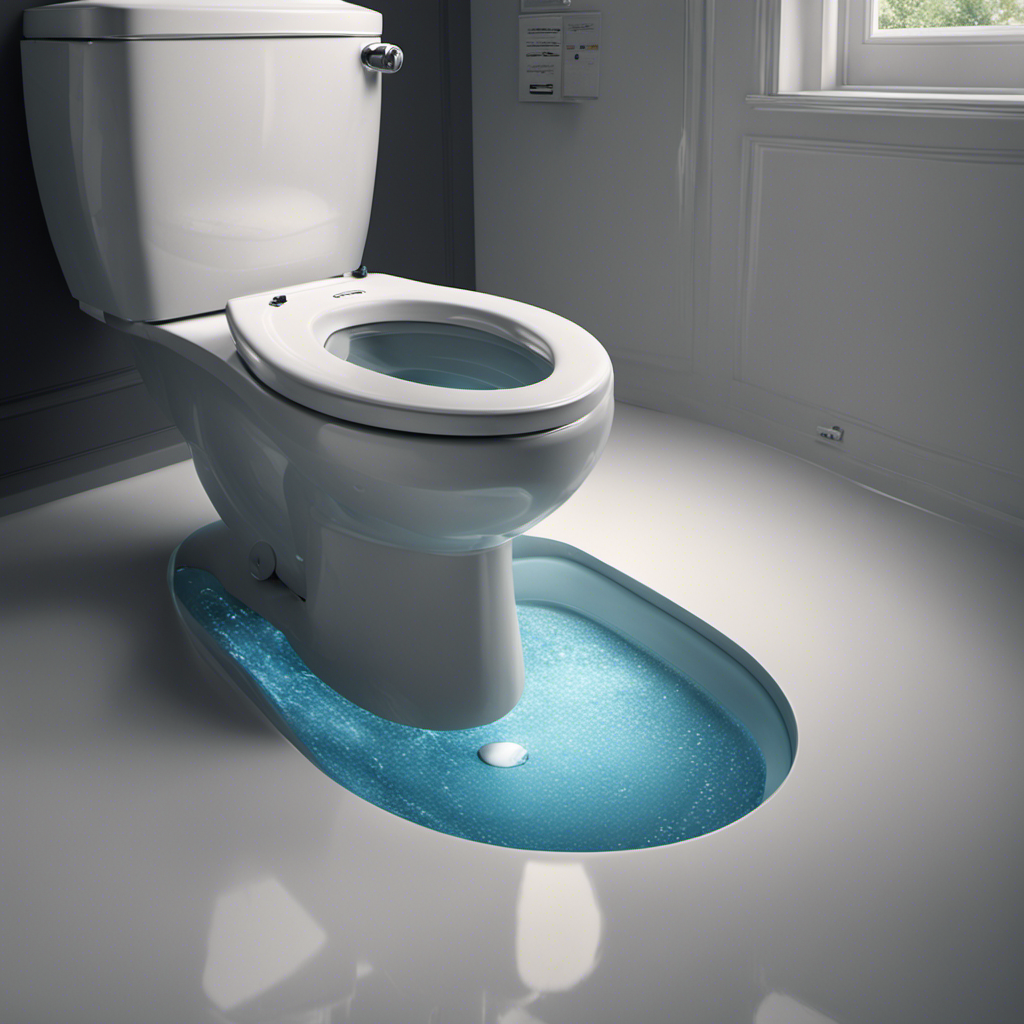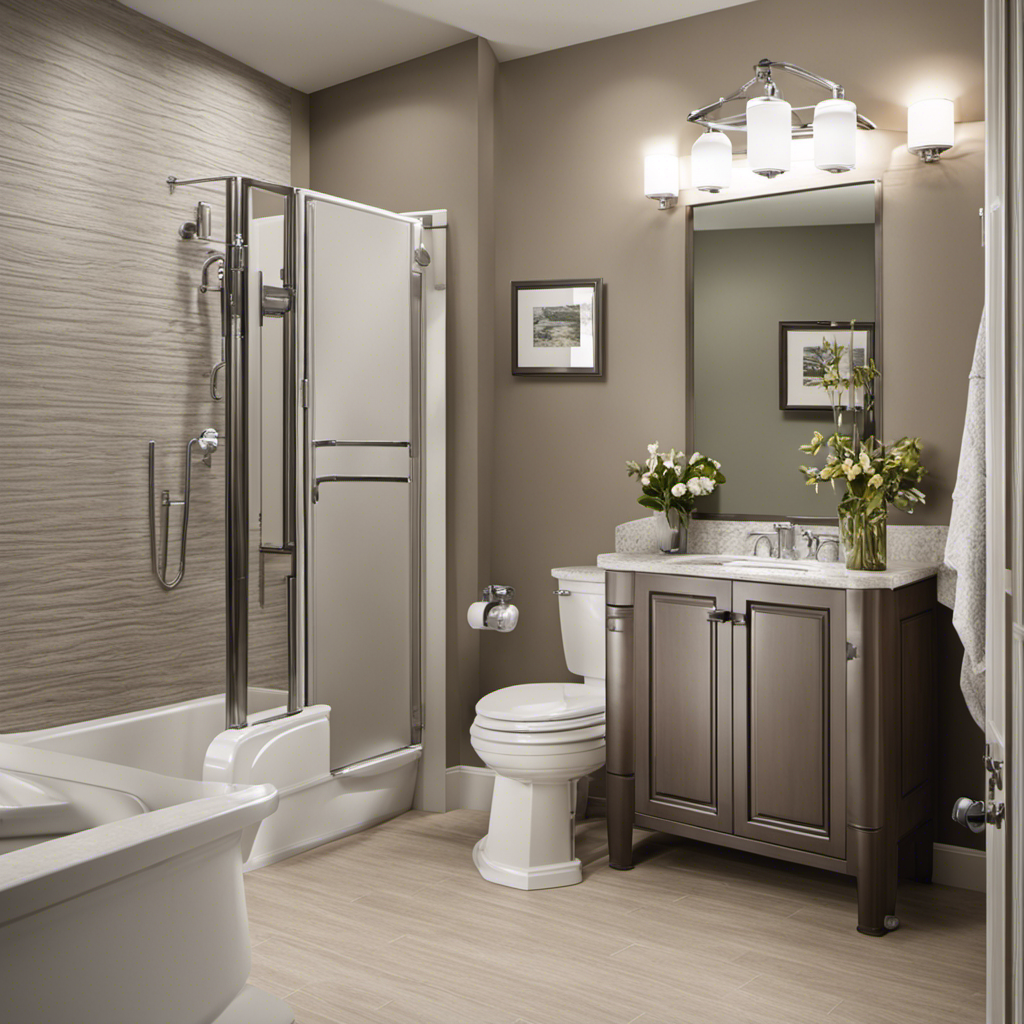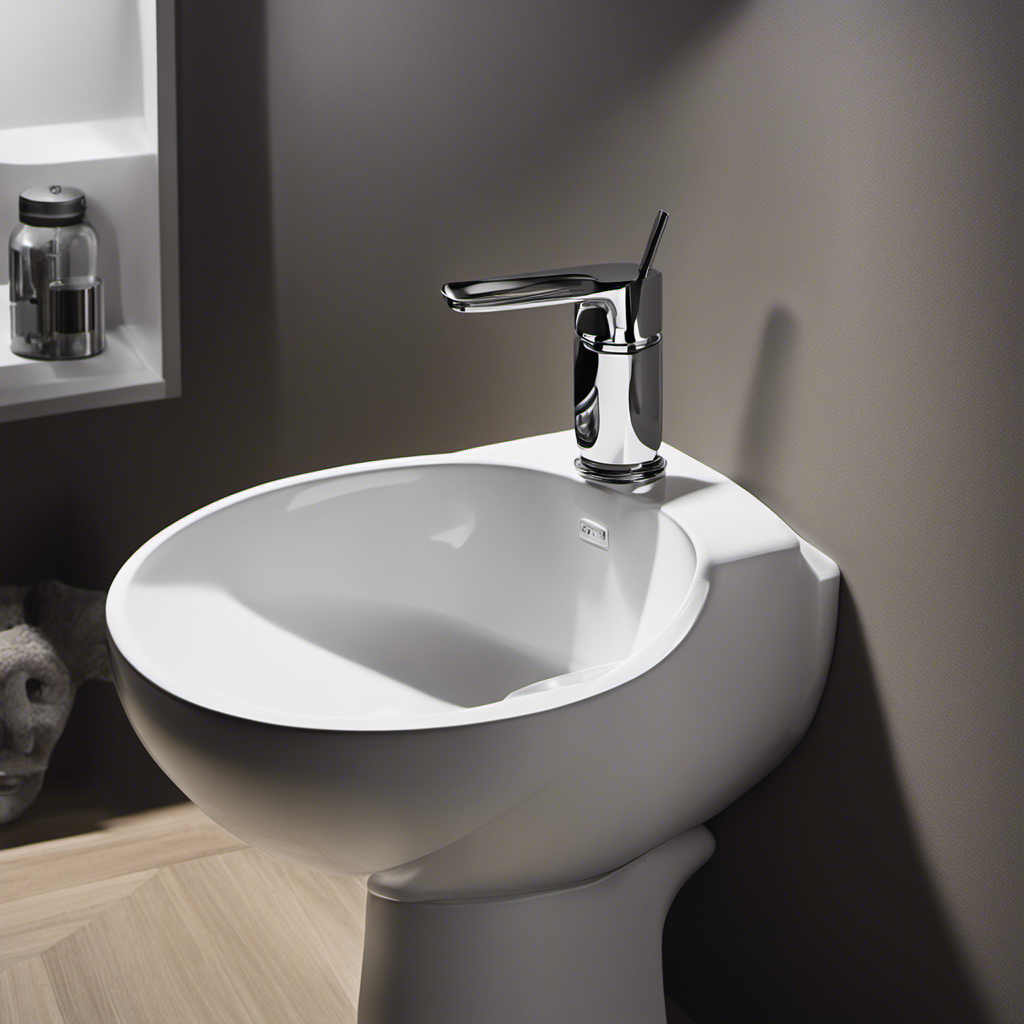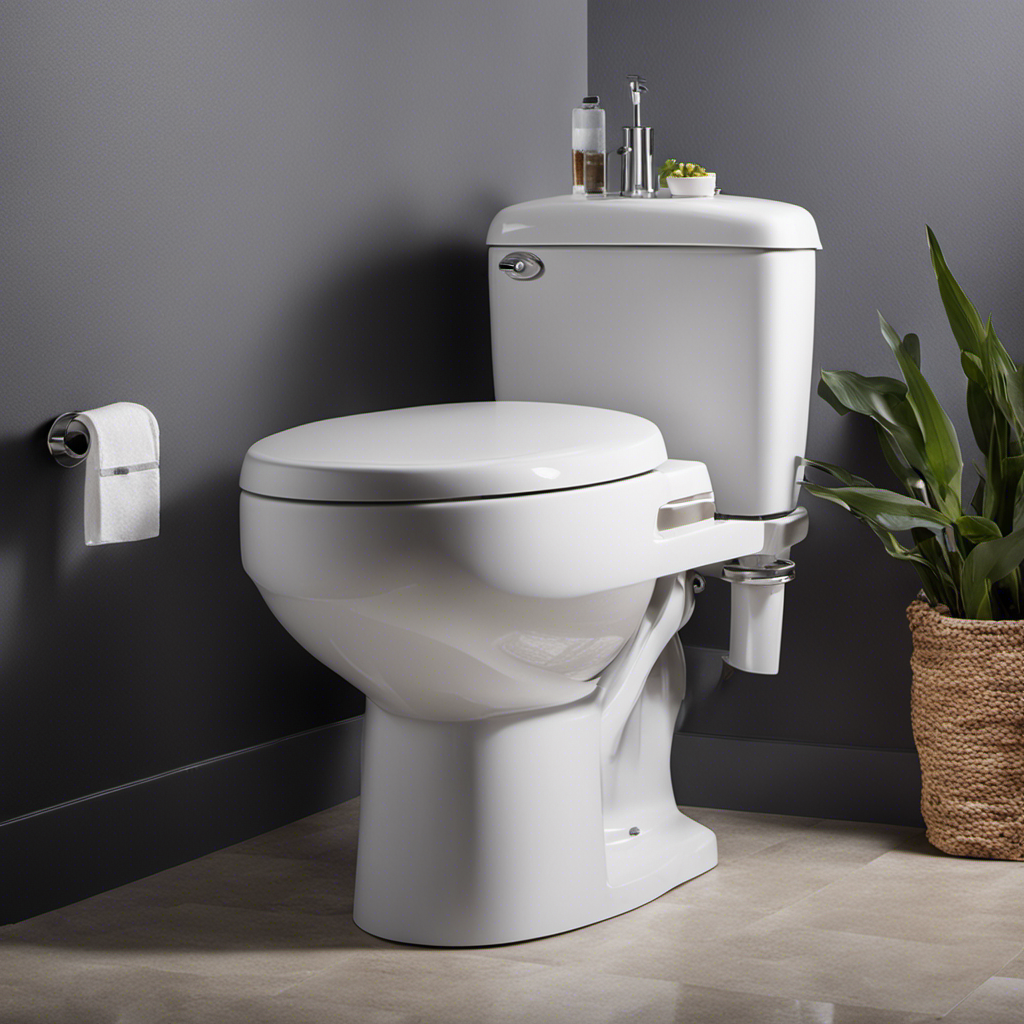Hey there! Ever wondered why your toilet is leaking from the base? Well, I’ve got some answers for you.
In this article, we’ll explore the common causes of toilet leaks, how to identify the source of the leakage, and most importantly, how to fix it.
We’ll also discuss preventive measures to avoid future leaks and the signs of a damaged wax ring and toilet bolts.
Don’t worry, I’ve got you covered with all the information you need to tackle this issue head-on.
Let’s get started, shall we?
Key Takeaways
- Faulty or deteriorated wax ring is a common cause of toilet leaks from the base.
- Water pooling or dampness at the base of the toilet, foul odor, and gurgling sound when flushing are signs of a leaking toilet base.
- Steps to fix a leaking toilet base include checking for water pooling, replacing the wax ring if necessary, and reseating the toilet securely.
- Preventive measures to avoid toilet base leaks include proper installation techniques, regular maintenance checks, and using quality materials.
Common Causes of Toilet Leaking From the Base
One of the most common causes of a toilet leaking from the base is a faulty wax ring. The wax ring is a critical component that seals the connection between the toilet and the sewer pipe. Over time, the wax ring can deteriorate or become misaligned, resulting in water leakage.
To identify a leak, start by inspecting the base of the toilet for any signs of water pooling or dampness. Additionally, if you notice a foul odor or hear a gurgling sound when you flush, it may indicate a leak.
To repair the leak, you will need to remove the toilet, replace the wax ring, and reinstall the toilet properly. It’s important to ensure a tight seal to prevent future leaks.
Identifying the Source of the Leakage
To identify where the leakage is coming from, start by checking the water supply and the connection between the tank and the bowl. This is an important step in troubleshooting leakage causes. By examining these areas, you can pinpoint the source of the problem and take appropriate action. To make it easier to understand, I have provided a table below that outlines the most common leaks and their potential causes:
| Common Leaks | Potential Causes |
|---|---|
| Leaking water supply | Loose or damaged water supply line or valve |
| Leaking tank-to-bowl | Faulty tank-to-bowl gasket or bolts |
| Leaking wax seal | Worn-out or improperly installed wax seal |
How to Fix a Leaking Toilet Base
Check underneath the toilet for any water pooling or dampness, as this could indicate a leaking toilet base. If you notice water around the base, it’s important to address the issue promptly to prevent further damage.
Fortunately, toilet base repair can often be done as a DIY project. First, turn off the water supply to the toilet by shutting off the valve located behind the toilet. Next, remove the toilet by disconnecting the water supply line and unscrewing the bolts that secure it to the floor.
Inspect the wax ring, which seals the toilet to the sewer pipe, and replace it if necessary. Clean the area around the base thoroughly before reseating the toilet and securing it back in place. Finally, turn on the water supply and check for any leaks.
With some basic tools and a little patience, fixing a leaking toilet base can be a simple and cost-effective DIY solution.
Preventive Measures to Avoid Toilet Base Leaks
When it comes to preventing toilet base leaks, there are three key points to consider: proper installation techniques, regular maintenance checks, and using quality materials.
Proper installation techniques ensure that all components are securely connected, minimizing the risk of leaks.
Regular maintenance checks allow for early detection of any potential issues, preventing leaks from worsening.
Using quality materials ensures that the toilet is built to withstand everyday use, reducing the chances of leaks occurring in the first place.
Proper Installation Techniques
Make sure you’ve tightened the bolts on the base of your toilet to prevent any leaks. Proper installation techniques are crucial in ensuring a leak-free toilet. Here are some key steps to follow:
- Ensure the toilet flange is properly secured to the floor.
- Use a wax ring or a foam gasket to create a watertight seal between the toilet and the flange.
- Tighten the bolts evenly and firmly to secure the toilet to the floor.
Troubleshooting toilet leaks involves identifying the source of the problem. If the leak persists despite proper installation, consider these possible issues:
- Cracked toilet base: Replace the toilet if you notice any cracks.
- Damaged wax ring: Replace the wax ring to create a new seal.
- Loose or damaged bolts: Tighten or replace the bolts if necessary.
Regular maintenance checks are essential to prevent leaks and ensure the longevity of your toilet.
Regular Maintenance Checks
To prevent potential leaks, ensure you routinely inspect the condition of the wax ring and bolts securing your toilet. Regular maintenance is crucial to keep your toilet functioning properly and prevent any water damage.
Checking for leaks is an important step in this maintenance routine. Leaks can occur at the base of the toilet, which can lead to water seeping into the floor and causing structural damage.
To check for leaks, start by examining the wax ring. Look for any signs of deterioration or gaps between the ring and the toilet base.
Next, inspect the bolts that secure the toilet to the floor. Ensure they are tightened properly and not rusted or damaged.
Using Quality Materials
You should consider using high-quality materials for your toilet to ensure its longevity and minimize the risk of leaks. Using durable materials has several advantages:
-
Increased durability: High-quality materials such as ceramic or porcelain are less likely to crack or break, providing a longer lifespan for your toilet.
-
Better sealing: Quality materials contribute to a tighter seal between the toilet and the floor, reducing the chances of leaks from the base.
-
Improved water efficiency: Some high-quality toilets feature advanced technologies that minimize water consumption, helping you save on your water bills.
Investing in high-quality materials for your toilet may require a higher upfront cost, but it can save you money in the long run by preventing costly repairs and reducing water wastage. Additionally, it ensures a reliable and efficient toilet system for years to come.
Signs of a Damaged Wax Ring in a Toilet
As a homeowner, it is important to be aware of certain signs that may indicate a damaged wax ring in your toilet.
One common sign is water on the bathroom floor around the base of the toilet. This can be caused by a faulty wax ring that is no longer creating a watertight seal.
Another indication of a damaged wax ring is a foul odor near the toilet, which can be a result of sewage gases escaping through the gap between the toilet and the floor.
Additionally, if you notice that your toilet is loose or wobbly, it could be a sign that the wax ring has deteriorated and needs to be replaced.
Water on Bathroom Floor
Check if the water on your bathroom floor is coming from the base of your toilet. This is a common issue that can lead to bathroom flooding and water damage if not addressed promptly.
Here are some possible reasons for water on the bathroom floor:
- Damaged Wax Ring: The wax ring seals the connection between the toilet and the floor drain. If it is compromised or worn out, water can seep out from the base of the toilet.
- Loose Toilet Bolts: Over time, the bolts that secure the toilet to the floor can become loose, allowing water to escape.
- Cracked Toilet Base: A cracked base can also cause water to leak onto the floor.
If you notice water pooling around the base of your toilet, it is important to take action to prevent further damage.
Foul Odor Near Toilet
After noticing water on the bathroom floor, I also detected a foul odor near my toilet. This could be a sign of a problem with the toilet flange, which is the circular piece that connects the toilet to the floor.
If the toilet flange is damaged or not properly sealed, it can lead to leaks and sewage smells. The flange may have become cracked or broken over time, causing water to seep out onto the floor and allowing sewer gases to escape. Additionally, the flange may have become loose, creating gaps where odors can escape.
It is important to address this issue promptly to prevent further floor damage and to maintain a sanitary bathroom environment.
Loose or Wobbly Toilet
The loose or wobbly toilet can be a result of a damaged or improperly installed toilet flange. When the toilet flange, which is a pipe fitting that connects the toilet to the floor, is damaged or not installed correctly, it can compromise the stability of the toilet and cause it to wobble. This not only affects the comfort and safety of using the toilet but can also lead to further issues such as leaks and floor damage.
Toilet stability is crucial for a functional bathroom, and addressing a loose or wobbly toilet is essential. Here are some potential reasons for a loose or wobbly toilet:
- Improper installation of the wax ring between the toilet flange and the toilet base
- Damaged or corroded toilet flange
- Loose toilet anchor bolts
If left unattended, a loose or wobbly toilet can cause damage to the floor around the toilet and even result in water leaks. It is important to address this issue promptly to ensure toilet stability and prevent further problems.
Understanding the Role of Toilet Bolts in Base Leaks
Toilet bolts are essential components that help secure the toilet base in place, preventing leaks from occurring. When the toilet bolts become damaged or worn out, they need to be replaced promptly to maintain a tight toilet base.
The importance of a tight toilet base cannot be overstated. It ensures that there are no gaps between the toilet and the floor, which can lead to water leakage. When toilet bolts are loose or missing, the toilet can become wobbly, causing stress on the wax ring and the flange. This can result in water seeping out from the base.
Therefore, regular inspection and replacement of toilet bolts is crucial in maintaining a tight and leak-free toilet base.
Consulting a Professional for Severe Toilet Base Leaks
Consulting a professional is recommended for severe leaks in the toilet base, as they have the expertise to diagnose and fix the issue effectively. When it comes to toilet base leaks, it’s crucial to understand the role of professional services in addressing this problem. Here are some key reasons why consulting a professional is the best course of action:
- Knowledge and expertise: Professionals are trained to identify the root cause of the leak and determine the most appropriate solution.
- Specialized tools and equipment: Professionals have access to specialized tools and equipment that are necessary for fixing the issue accurately.
- Warranty and guarantee: Hiring a professional often comes with a warranty or guarantee, providing peace of mind that the problem will be resolved.
While there are some DIY solutions available for minor leaks, severe toilet base leaks require the skills and experience of a professional to ensure a long-lasting and effective repair.
Frequently Asked Questions
Can I Use Caulk to Fix a Leaking Toilet Base?
Yes, you can use caulk as a temporary fix for a leaking toilet base. However, it is recommended to seek professional plumbing services to identify and address the underlying issue. Caulk alternatives may provide more durable and long-term solutions.
How Do I Know if the Wax Ring Is Damaged?
When inspecting my toilet, I check for signs of water damage and assess the condition of the wax ring. Common causes of leaks include a damaged wax ring, loose bolts, or a cracked toilet base.
Can I Fix a Leaking Toilet Base by Tightening the Toilet Bolts?
Yes, tightening toilet bolts can sometimes fix a leaking toilet base. However, if that doesn’t solve the problem, there are alternative solutions such as replacing the wax ring or calling a professional plumber for assistance.
Are There Any Specific Preventive Measures to Avoid Toilet Base Leaks in Older Toilets?
To prevent toilet base leaks in older toilets, regular maintenance is key. Inspect the wax ring and bolts for wear and replace as needed. Consider using a toilet base sealant for added protection.
What Are the Signs That Indicate a Severe Toilet Base Leak That Requires Professional Help?
When signs of a severe toilet base leak arise, it’s crucial to seek professional help. Ignoring the issue can lead to further damage and costly repairs. Don’t hesitate to call a plumber for assistance.
Conclusion
In conclusion, if you notice your toilet leaking from the base, it is important to address the issue promptly to avoid further damage and potential water waste.
While some leaks can be fixed easily with a few simple steps, severe leaks may require professional assistance.
Don’t procrastinate, as a leaking toilet can lead to costly repairs and increased water bills.
By taking preventive measures and regularly inspecting your toilet, you can avoid the inconvenience and expense of a leaking toilet base.










